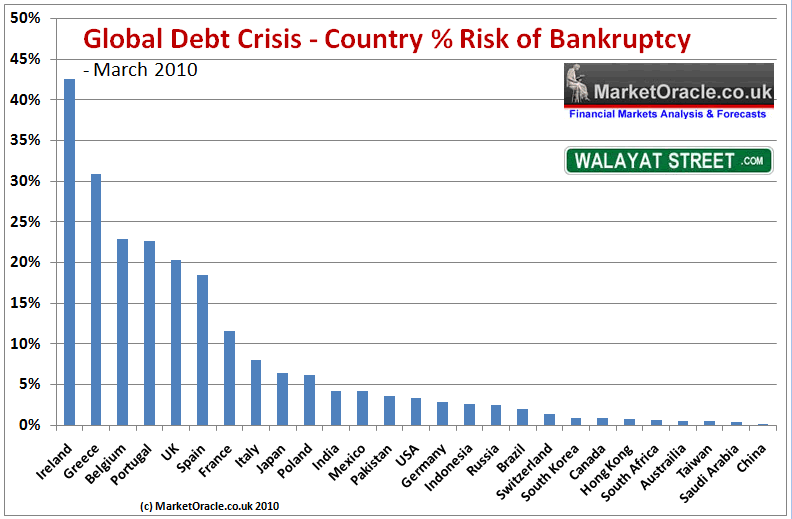"All countries are on the path towards bankruptcy, to measure where a country stands along this path it is critical to look beyond official statistics that focus primarily on public sector net debt and the annual budget deficit in terms of % of GDP.
The key item missing from most commentary on this subject matter is debt and liabilities that are denominated in foreign currencies as that can mask a stealth trend towards potentially imminent bankruptcy that can suddenly blow up in the face of a countries citizens who had been previously mislead by official statistics into thinking that the debt situation was under control, much as Icelanders experienced during 2008 where one day they enjoyed one of the highest standards of living amongst westerners to next day wake up to be bankrupt and poorer in terms of purchasing power than many third world countries. The key driver for state bankruptcy and currency collapse is the amount a country owes or is liable to foreigners, as debt denominated in foreign currencies cannot be inflated away as governments can do with domestic debt so it is one of the primary driving forces for a country going bankrupt as it is unable to meet the increasing interest payments due in foreign currency as its own currency falls.
The following graph attempts to paint an accurate picture of the current relative state of the trend towards bankruptcy of the worlds major economies which takes into account public and private debt, unfunded liabilities, budget deficits, and debt denominated in foreign currencies, as well as taking into account the historic track record of the countries in dealing with past debt crisis. The results are shown as a % of the countries risk of going bankrupt where Iceland would be at 100% following its defacto debt default.

Whilst the mainstream press these past two months has been obsessed with the Greek debt crisis, the above graph clearly illustrates that a far larger debt crisis looms in Ireland that could soon transplant Greece in the debt crisis headlines over the coming months, similarly a number of other Euro Zone countries head the risk towards bankruptcy league table with Belgium and Portugal not far behind Greece. The price that these countries pay for being stuck in the Euro single currency is that they cannot devalue to try and gain some competitive advantage for their economies and therefore try and grow and inflate their way out of a high debt burden that stifles economic activity. "
http://www.marketoracle.co.uk/Article18622.html
The key item missing from most commentary on this subject matter is debt and liabilities that are denominated in foreign currencies as that can mask a stealth trend towards potentially imminent bankruptcy that can suddenly blow up in the face of a countries citizens who had been previously mislead by official statistics into thinking that the debt situation was under control, much as Icelanders experienced during 2008 where one day they enjoyed one of the highest standards of living amongst westerners to next day wake up to be bankrupt and poorer in terms of purchasing power than many third world countries. The key driver for state bankruptcy and currency collapse is the amount a country owes or is liable to foreigners, as debt denominated in foreign currencies cannot be inflated away as governments can do with domestic debt so it is one of the primary driving forces for a country going bankrupt as it is unable to meet the increasing interest payments due in foreign currency as its own currency falls.
The following graph attempts to paint an accurate picture of the current relative state of the trend towards bankruptcy of the worlds major economies which takes into account public and private debt, unfunded liabilities, budget deficits, and debt denominated in foreign currencies, as well as taking into account the historic track record of the countries in dealing with past debt crisis. The results are shown as a % of the countries risk of going bankrupt where Iceland would be at 100% following its defacto debt default.

Whilst the mainstream press these past two months has been obsessed with the Greek debt crisis, the above graph clearly illustrates that a far larger debt crisis looms in Ireland that could soon transplant Greece in the debt crisis headlines over the coming months, similarly a number of other Euro Zone countries head the risk towards bankruptcy league table with Belgium and Portugal not far behind Greece. The price that these countries pay for being stuck in the Euro single currency is that they cannot devalue to try and gain some competitive advantage for their economies and therefore try and grow and inflate their way out of a high debt burden that stifles economic activity. "
http://www.marketoracle.co.uk/Article18622.html